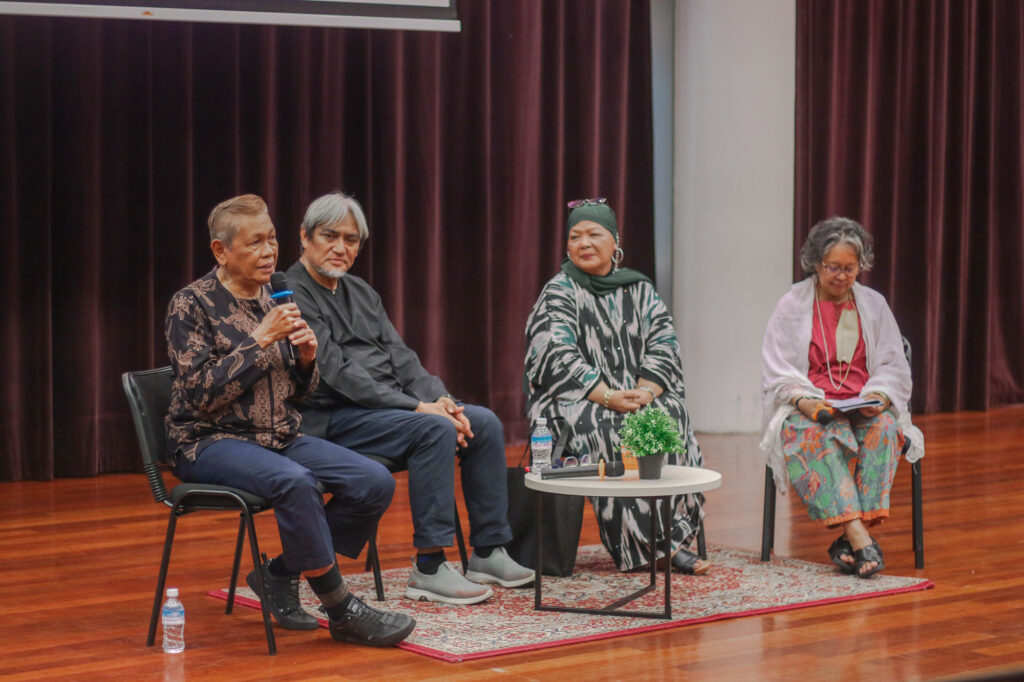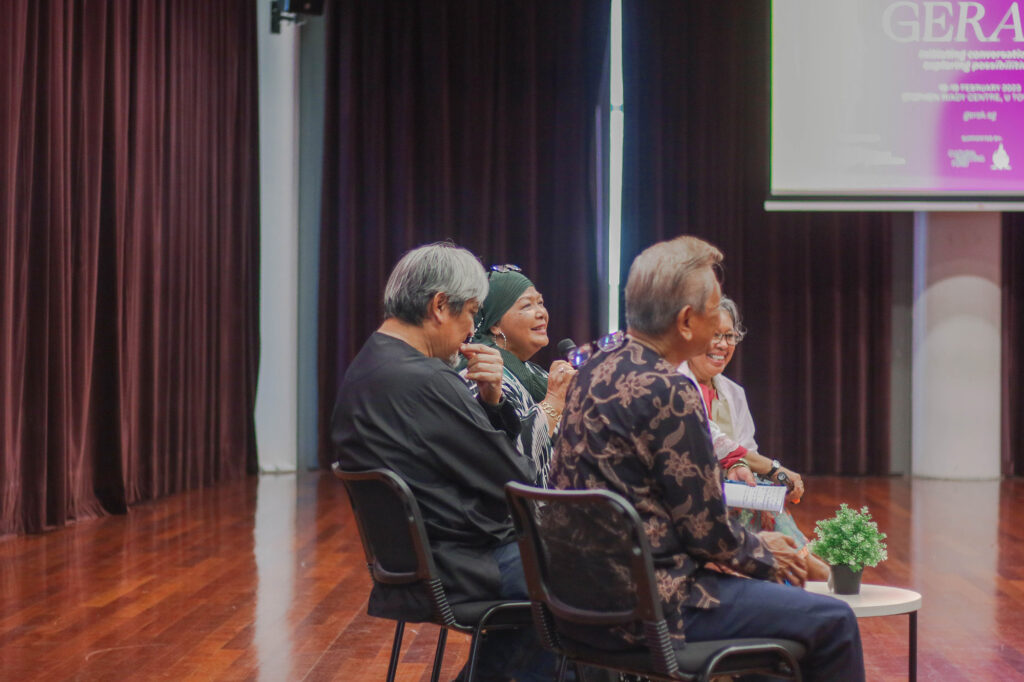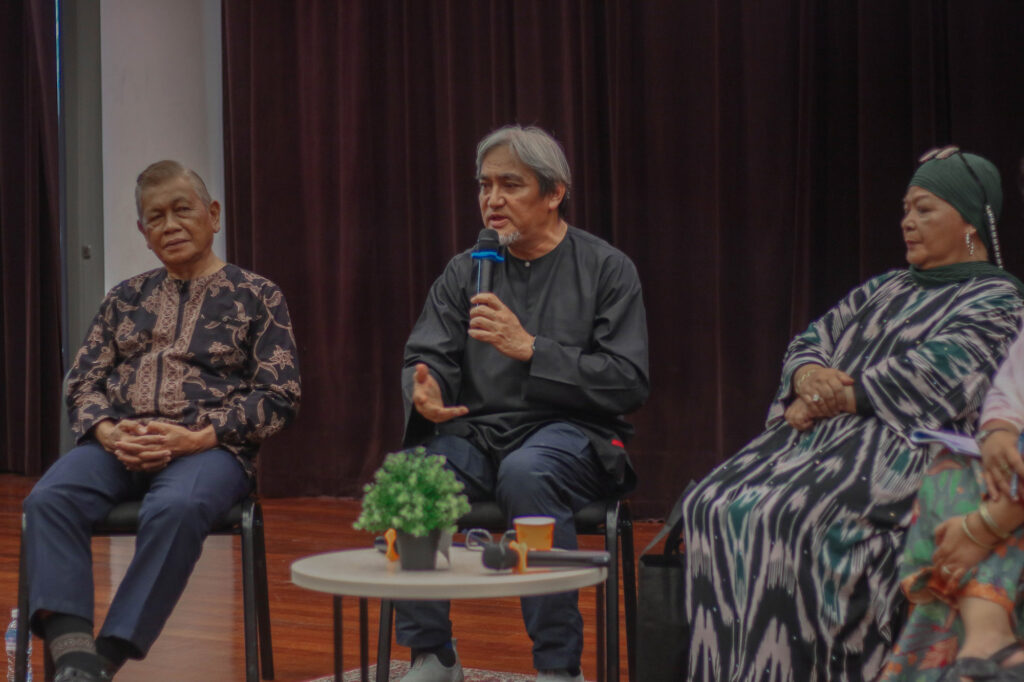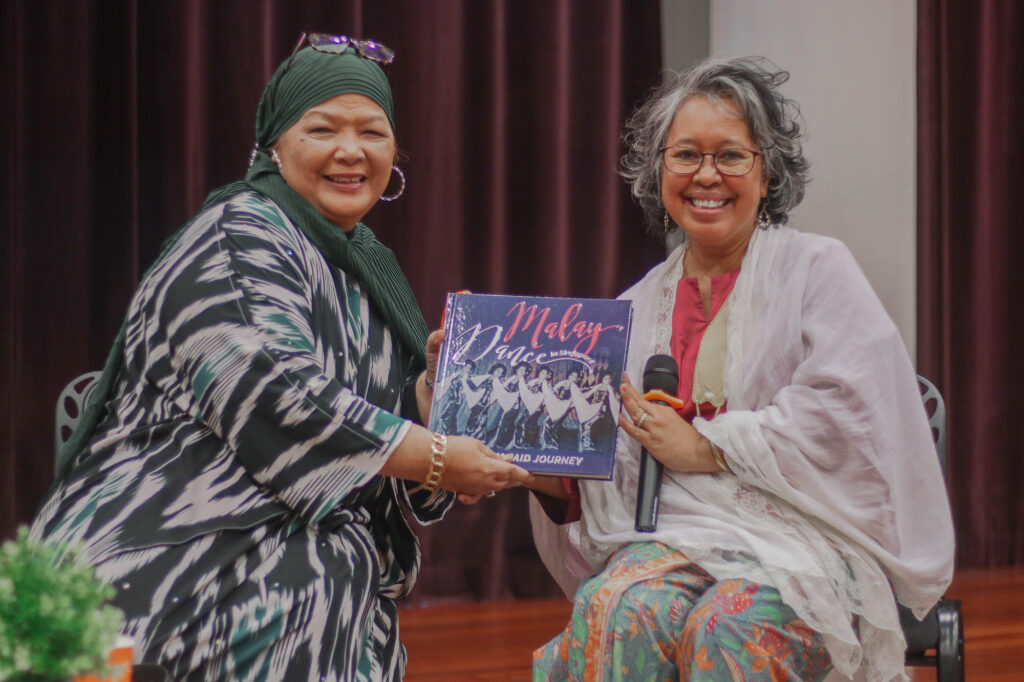Geraklah! – How Malay Dance Veterans Arrive to Where They Are At Today
By Rossy Sri Julyana Bte Jumahat (2023)
We all have different starting points, but we keep moving forward – Two generations of artists; one conversation on Malay dance in Singapore over the last 50 years.
Following Dr Noramin Farid’s session on the evolution of Malay dance in Singapore, respectable figures in the Malay dance scene – Mr Na’aim Pani, Mdm Som Said, and Mr Osman Abdul Hamid – gathered to share their rich experiences of their Malay dance practices.

“When I was in Secondary School…”
Some common experiences that were drawn out from the sharing included how these veterans began their dance journey while they were still in school. Mdm Som, who was a schoolgirl back then, would often imitate the dance moves from the movies she watched with her two elder sisters. She then met Ms Sri Rahayu – daughter of a movie producer S. Sudarmaji, and Mdm Som’s “first dancing partner” – and was eventually introduced to Sriwana as a learner and, soon after, a teacher of traditional Malay dance in the troupe.

While Mr Na’aim’s father frequented the Bunga Tanjong dance hall to dance with the dance-hall ladies, Mr Na’aim’s mother disliked the now veteran Malay dancer being a dancer. In fact, she wanted Mr Na’aim to be a policeman just like his uncles after “seeing how nice the uniform is”. However, watching his grandfather doing silat since he was seven years old slowly eased Mr Na’aim into learning Zapin and eventually accepting the invitation of his Secondary 1 teacher who was looking for dancers. His mother had also accepted Mr Na’aim dancing when she saw him appearing on the television and in the newspapers. Nevertheless, Mr Na’aim fulfilled his mother’s initial wish when he became the National Police Cadet Corp senior commander in the school he was teaching.
Mr Osman’s starting point was interesting, for he was not keen to dance initially due to the image attached to the art – he did not want to be perceived as “pondan” or sissy by joining a dance group. He spent most of his school-going years playing sports, until he gave in to the invitation from the school which was looking for male dancers. While he relented because of his friend, Mr Osman continued refining his craft as he was introduced to various teachers and dancers from Sriwana, the People’s Association (PA), and the National Dance Company (NDC) in the subsequent years.
These experiences by our veterans would not have happened if they did not accept the school’s invitation to dance, highlighting the school’s role in encouraging and becoming spaces for Malay dance. This is something I personally agree as well, for I started practising Malay dance due to the existence of such dance groups in school.
“The Body has embodied other dances”
As Dr Noramin’s sharing was still fresh in the veterans’ minds, they also went on to narrate their personal experiences dancing in international festivals. Mr Na’aim and Mdm Som were well-known for their chemistry in NDC to the point whereby people mistook them as a married couple. It was natural for people to make that assumption when Mr Na’aim’s dance experiences were closely interconnected with Mdm Som’s – he opened up his own dance group in the same year Sri Warisan Som Said Performing Arts Ltd was established, and both Mr Na’aim and Mdm Som had been each other’s dance partners while they represented Singapore on international stages.
The veterans agreed that the Adelaide Arts Festival in 1972 was a significant moment for Malay dance practitioners in Singapore as the experiences gained from the event changed how dance is practised here. Mdm Som realised the need for standardisation in performances when she watched how other dancers would ensure their dance steps were synchronised – every movement had to be executed with great precision.

“Preserve, Promote and Create”
Mdm Som also shared her philosophy as a dance practitioner: to preserve, promote, and create. Mdm Som believes that dance communities should preserve their foundations, which can be especially critical on international grounds whereby dancers have to represent themselves (in which foundations will come into play here). It is also crucial for these communities to continuously promote their works and expose potential audiences to the world of Malay dance. Lastly, there should be ample opportunities for dancers to develop their choreographies and learn dance moves beyond Malay dance to incorporate into their practices.

Several questions were raised by the audience regarding Mdm Som’s philosophy, particularly on the emphasis on performing Malay dance in the eyes of the international audience. For Mdm Som, she sees the importance of international exposure for Malay dance to remain alive in this world. As long as there are continuous promotional efforts by the dance communities, the Malay dance culture will very much exist in the minds of those who have witnessed it.
The other veterans also contributed to Mdm Som’s philosophy by stressing the need to stay true to yourself despite facing criticisms for the works produced. Mr Osman recounted a time when the local practitioners questioned his performance at Yogyakarta. What they saw was nothing like the Malay dance they usually envisioned, and such comments did not deter Mr Osman’s motivation to continue his craft as he presented his performances as “not Malay, not Indian, but Osman Abdul Hamid”.
“… think Gerak!”
At the end of the session, Dr Suriani Suratman posed a question to everyone in the room to reflect on: acknowledging the importance of preserving, promoting, and creating in the Malay dance industry, what then should we preserve, promote, and create? For Mr Osman, that decision stemmed from individual responsibility to value the existence of Malay dance.
Mr Na’aim tied the discussion neatly by viewing Mdm Som’s philosophy as 3 in 1: the one being gerak (to move) – synonymous with the title of our symposium. He believes movement is essential because no amount of theory will be sufficient if a person does not move in Malay dance.
As someone who recently started learning Malay dance this past year, it was a humbling and eye-opening experience for me to listen to the veteran’s sharings on their encounters with Malay dance. I joined NUS Ilsa Tari to try out something new, and perhaps make dance my new hobby. Yet, what struck me the most from the session, was the veteran’s philosophy and professionalism towards Malay dance. There is a tendency to question the viability of Malay dance as a career – Is it worthwhile to pursue Malay dance “full time”, or should it remain as a hobby? While this can potentially be the concerns of other student dancers like myself, it is comforting to know that these veterans too were once inexperienced student-dancers. As visionary dance practitioners, these veterans are living examples of passion and hardwork; that translates to their successful careers in Malay dance. Regardless of whether one pursues Malay dance as a career, or a hobby, we all have to start from “somewhere” – so, let’s GERAK!
